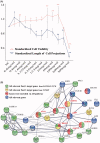Aconiti lateralis Radix Praeparata inhibits Alzheimer's disease by regulating the complex regulation network with the core of GRIN1 and MAPK1
- PMID: 33784489
- PMCID: PMC8018400
- DOI: 10.1080/13880209.2021.1900879
Aconiti lateralis Radix Praeparata inhibits Alzheimer's disease by regulating the complex regulation network with the core of GRIN1 and MAPK1
Abstract
Context: Current medicine for Alzheimer's disease (AD) cannot effectively reverse or block nerve injury. Traditional Chinese Medicine practice and research imply Aconiti lateralis Radix Praeparata (Fuzi) may meet this goal.
Objective: Analysing the anti-AD effect of Fuzi and its potential molecular mechanism.
Materials and methods: AD model cells were treated with Fuzi in 0-300 mg/mL for 24 h in 37 °C. The cell viability (CV) and length of cell projections (LCP) for each group were observed, analysed, and standardised using control as a baseline (CVs and LCPs). The Fuzi and AD relevant genes were identified basing on databases, and the molecular mechanism of Fuzi anti-AD was predicted by network analysis.
Results: Experiment results showed that Fuzi in 0.4 mg/mL boosted LCP (LCPs = 1.2533, p ≤ 0.05), and in 1.6-100 mg/mL increased CV (CVs from 1.1673 to 1.3321, p ≤ 0.05). Bioinformatics analysis found 17 Fuzi target genes (relevant scores ≥ 20), showing strong AD relevant signals (RMS_p ≤ 0.05, related scores ≥ 5), enriched in the pathways regulating axon growth, synaptic plasticity, cell survival, proliferation, apoptosis, and death (p ≤ 0.05). Especially, GRIN1 and MAPK1 interacted with APP protein and located in the key point of the "Alzheimer's disease" pathway.
Discussion and conclusions: These results suggest that Fuzi may have therapeutic and prevention potential in AD, and GRIN1 and MAPK1 may be the core of the pathways of the Fuzi anti-AD process. Fuzi should be studied more extensively, especially for the prevention of AD.
Keywords: APP cells; Fuzi; aminophenol; therapy.
Conflict of interest statement
The authors report no declarations of interest. The authors alone are responsible for the content and writing of the paper.
Figures




Similar articles
-
Integrated serum pharmacochemistry, network pharmacology and experimental verification to explore the mechanism of Aconiti Lateralis Radix Praeparata in treatment of lung cancer.J Pharm Biomed Anal. 2025 Jan 1;252:116472. doi: 10.1016/j.jpba.2024.116472. Epub 2024 Sep 11. J Pharm Biomed Anal. 2025. PMID: 39278160
-
[Core connotation of compatibility of Aconiti Lateralis Radix Praeparata-Glycyrrhizae Radix et Rhizoma herb pair under physiological/ pathological conditions based on metabolomics and network pharmacology].Zhongguo Zhong Yao Za Zhi. 2023 Jul;48(14):3793-3805. doi: 10.19540/j.cnki.cjcmm.20230425.301. Zhongguo Zhong Yao Za Zhi. 2023. PMID: 37475071 Chinese.
-
Assessment of reproductive toxicity and genotoxicity of Aconiti Lateralis Radix Praeparata and its processed products in male mice.J Ethnopharmacol. 2021 Jul 15;275:114102. doi: 10.1016/j.jep.2021.114102. Epub 2021 Apr 6. J Ethnopharmacol. 2021. PMID: 33831471
-
Relationships between the Toxicities of Radix Aconiti Lateralis Preparata (Fuzi) and the Toxicokinetics of Its Main Diester-Diterpenoid Alkaloids.Toxins (Basel). 2018 Sep 26;10(10):391. doi: 10.3390/toxins10100391. Toxins (Basel). 2018. PMID: 30261585 Free PMC article. Review.
-
Neuropharmacological effects of Aconiti Lateralis Radix Praeparata.Clin Exp Pharmacol Physiol. 2020 Apr;47(4):531-542. doi: 10.1111/1440-1681.13228. Epub 2020 Jan 23. Clin Exp Pharmacol Physiol. 2020. PMID: 31837236 Review.
Cited by
-
Discovery and Prediction Study of the Dominant Pharmacological Action Organ of Aconitum carmichaeli Debeaux Using Multiple Bioinformatic Analyses.Int J Mol Sci. 2024 Sep 23;25(18):10219. doi: 10.3390/ijms251810219. Int J Mol Sci. 2024. PMID: 39337710 Free PMC article.
-
Integrated network analysis and metabolomics reveal the molecular mechanism of Yinchen Sini decoction in CCl4-induced acute liver injury.Front Pharmacol. 2023 Sep 25;14:1221046. doi: 10.3389/fphar.2023.1221046. eCollection 2023. Front Pharmacol. 2023. PMID: 37818184 Free PMC article.
-
Neuropharmacological Potential of Diterpenoid Alkaloids.Pharmaceuticals (Basel). 2023 May 14;16(5):747. doi: 10.3390/ph16050747. Pharmaceuticals (Basel). 2023. PMID: 37242531 Free PMC article. Review.
References
-
- Agca C, Klakotskaia D, Stopa EG, Schachtman TR, Agca Y.. 2020. Ovariectomy influences cognition and markers of Alzheimer’s disease. J Alzheimers Dis. 73(2):529–541. - PubMed
-
- Ahmad Rather M, Justin Thenmozhi A, Manivasagam T, Dhivya Bharathi M, Essa MM, Guillemin GJ.. 2018. Neuroprotective role of asiatic acid in aluminium chloride induced rat model of Alzheimer’s disease. Front Biosci (Schol Ed). 10:262–275. - PubMed
-
- Ali T, Kim T, Rehman SU, Khan MS, Amin FU, Khan M, Ikram M, Kim MO.. 2018. Natural dietary supplementation of anthocyanins via PI3K/Akt/Nrf2/HO-1 pathways mitigate oxidative stress, neurodegeneration, and memory impairment in a mouse model of Alzheimer’s disease. Mol Neurobiol. 55(7):6076–6093. - PubMed
MeSH terms
Substances
LinkOut - more resources
Full Text Sources
Other Literature Sources
Medical
Miscellaneous
